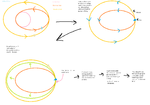Difference between revisions of "Tutorial: Advanced Orbiting/zh-cn"
(Create zh-cn Page for Advanced Orbiting) |
SlayerGames (talk | contribs) m (Moved to /zh-cn category) |
||
| (6 intermediate revisions by one other user not shown) | |||
| Line 1: | Line 1: | ||
| − | == | + | == 霍曼转移 == |
| − | + | 在轨道近拱点发动机点火正向推进(位于正圆轨道则可以在任意时刻进行),直到把轨道远拱点调整到期望高度。 | |
| − | + | 然后,当到达新的轨道远拱点时,再次进行正向推进,把轨道近拱点调整到期望的高度。 | |
| − | + | 以此类推,在相应拱点进行反向推进则可以降低轨道高度。 | |
| − | == | + | == 双椭圆转移 == |
| − | + | 在某些情况下,相比霍曼转移,双椭圆转移更为经济(但需要的时间相对较长)。 | |
| − | + | 首先,正向推进把轨道改变为椭圆轨道。 | |
| − | + | 在轨道远拱点进行正向推进,直到轨道近拱点上升到达期望的轨道高度。 | |
| − | + | 在到达轨道近拱点时,进行反向推进,直到轨道恢复正圆轨道。 | |
| − | + | 在相应点进行反向推进可以降低轨道高度。这样就可以帮助你利用[[aerobraking/zh-cn|气动刹车]]来降低轨道高度。 | |
| − | == | + | == 轨道平面对齐 == |
| − | + | 飞向其它天体的第一步就是把目前运行的轨道平面与目标轨道平面对齐。 | |
| − | + | 下一步是找到轨道的支点,Next is to find the pivot point on your orbit that, when turned clockwise or counterclockwise (视角为camera > ship > orbited object),will cause it to line up with the other orbit. | |
| − | + | 随后,Next, find the midpoint between your prograde and retrograde motion on the horizon and point your ship toward it. Throttling prograde + 90 degrees on the horizon will cause your orbit to rotate clockwise. Prograde - 90 degrees on the horizon will rotate the orbit counterclockwise. It may take a few rotation sessions to perfect your orbit but this will allow you to match another orbital plane. | |
It is easier to achieve if your orbit is circular, mostly because you can line up the orbits in the map view much more easily. | It is easier to achieve if your orbit is circular, mostly because you can line up the orbits in the map view much more easily. | ||
| Line 54: | Line 54: | ||
| − | [[Category:Tutorials]] | + | [[Category:Tutorials/zh-cn]] |
{{stub}} | {{stub}} | ||
Revision as of 18:44, 2 May 2019
Contents
霍曼转移
在轨道近拱点发动机点火正向推进(位于正圆轨道则可以在任意时刻进行),直到把轨道远拱点调整到期望高度。
然后,当到达新的轨道远拱点时,再次进行正向推进,把轨道近拱点调整到期望的高度。
以此类推,在相应拱点进行反向推进则可以降低轨道高度。
双椭圆转移
在某些情况下,相比霍曼转移,双椭圆转移更为经济(但需要的时间相对较长)。
首先,正向推进把轨道改变为椭圆轨道。
在轨道远拱点进行正向推进,直到轨道近拱点上升到达期望的轨道高度。
在到达轨道近拱点时,进行反向推进,直到轨道恢复正圆轨道。
在相应点进行反向推进可以降低轨道高度。这样就可以帮助你利用气动刹车来降低轨道高度。
轨道平面对齐
飞向其它天体的第一步就是把目前运行的轨道平面与目标轨道平面对齐。
下一步是找到轨道的支点,Next is to find the pivot point on your orbit that, when turned clockwise or counterclockwise (视角为camera > ship > orbited object),will cause it to line up with the other orbit.
随后,Next, find the midpoint between your prograde and retrograde motion on the horizon and point your ship toward it. Throttling prograde + 90 degrees on the horizon will cause your orbit to rotate clockwise. Prograde - 90 degrees on the horizon will rotate the orbit counterclockwise. It may take a few rotation sessions to perfect your orbit but this will allow you to match another orbital plane.
It is easier to achieve if your orbit is circular, mostly because you can line up the orbits in the map view much more easily.
Orbit Synchronization
In progress.
The Exley Maneuver
(As of 0.17.1)
In order to easily meet with a target planet's Sphere of Influence, you will need to perform a few burns while at either the Periapsis or Apoapsis of your transfer orbit.
Planets outside your original orbit
If you are meeting with a planet whose orbit is outside of your starting orbit, create a transfer orbit such that your Apoapsis is as close as possible to your target planet's orbit.
Next, make a few orbits until the target planet is slightly in front of you when you reach your Apoapsis. Begin a burn in the direction of your velocity until you see your orbit cross the target planet's near your Apoapsis for a fraction of a second. If you overshoot, simply turn around and burn against the direction of your velocity until the cross orbit is visible again. If your transfer orbit exceeds the planet's orbit, then you have gone too far, and have either missed the cross orbit, or do not have an Apoapsis close enough to the target orbit to be affected by the planet's Sphere of Influence.
Planets inside your original orbit
If you are meeting with a planet whose orbit is inside of your starting orbit, create a transfer orbit such that your Periapsis is as close as possible to your target planet's orbit.
Next, make a few orbits until the target planet is slightly behind you when you reach your Periapsis. Begin a burn in the opposite direction of your velocity until you see your orbit cross the target planet's near your Periapsis for a fraction of a second. If you overshoot, simply turn around and burn with the direction of your velocity until the cross orbit is visible again. If your transfer orbit goes within the planet's orbit, then you have gone too far, and have either missed the cross orbit, or do not have a Periapsis close enough to the target orbit to be affected by the planet's Sphere of Influence.
Finally
Once you are in the Cross Orbit, burn against the direction of your velocity until the orbit goes around your target planet.
Good luck!
